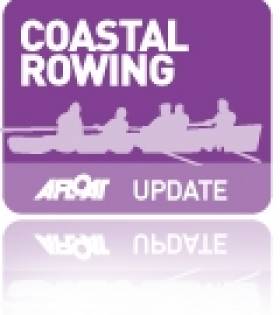Displaying items by tag: St Ayles Skiff
St. Ayles Skiff Racing at Skiffiefest 2023 Returns to Strangford Lough This Summer
A country park doesn’t readily come to mind as a venue for a weekend of St.Ayles Skiff racing, but Delamont lies on the shores of Strangford Lough near Killyleagh and has proved an ideal base for this activity in the past.
St. Ayles Skiff (pronounced Saint Isles) is a four-oared rowing boat designed by Iain Oughtred and inspired by the traditional Fair Isle skiff. The boat is clinker built, 6.7 m long with a beam of 1.7 m. and is normally crewed by four sweep rowers with a cox.
This season’s event, hosted by the Down Coastal Rowing Association, is on the weekend of the 5th and 6th of August and will include land and water-based activities for the whole family.
The schedule is for 33 races covering several age categories.
 A scene from the 2022 Skiffie Festival
A scene from the 2022 Skiffie Festival
1,500 rowers are expected to race in a mixed male and female format. David Larmour of the Association says, “As well as interest from eight or nine local clubs, we have had enquiries from fifteen Scottish clubs, one from England and a couple from Holland”.
The event is free to enter and supported by Newry and Mourne District Council and Sport NI.
In a great development for the St Ayles skiff class of Coastal Rowing Boat, four existing national associations have agreed to form an International Class Association, with a view to promoting the Class worldwide, ensuring the continuing success of SkiffieWorlds, and keeping the same high standards wherever St Ayles skiffs are raced. A Minute of Agreement was signed at SkiffieWorlds 2019 by Down Coastal Rowing Association (the Class Association for All Ireland), the Australian St Ayles Skiff Community Rowing Association, the Dutch St Ayles Rowing Association and the Scottish Coastal Rowing Association.
The agreement brings mutual recognition for each association and commits them to work together for the International Association.
For more information on how to enter or to see what's planned click here
New Kilrush Skiff Honours Ukraine And Clare
When it came to painting the new St Ayles skiff Ealu built by Seol Sionnas (the owners of the much-admired traditional cutter Sally O’Keeffe) under the direction of Steve Morris in Kilrush Boatyard, it was “No Contest” as regards décor choice. For County Clare the Banner County shares the same distinctive blue and bright yellow colours with beleaguered Ukraine.
And as it happens, there are three Ukrainian girls staying in Kilrush who were keen to help with the painting job. The result is one very smart-looking craft whose attractive handling characteristics and performance potential eloquently explain why the numbers of this special Iain Oughtred design have reached more than 400 boats worldwide.
 The new St Ayles skiff Ealu makes the traditional Kilrush maiden voyage of a sunwise circuit of the Holy Island of Scattery in the Shannon Estuary, rowing at “a comfortable four knots”. Photo: Trea Heaps
The new St Ayles skiff Ealu makes the traditional Kilrush maiden voyage of a sunwise circuit of the Holy Island of Scattery in the Shannon Estuary, rowing at “a comfortable four knots”. Photo: Trea Heaps
Ealu recently had the traditional Kilrush maiden voyage of a sunwise circuit of Scattery Island, and demonstrated that she can comfortably maintain a cruising rowing speed of four knots, so now “some fairly serious expeditions” are being planned with the able Sally O’Keeffe as support vessel.
 The ultimate multi-tasker – Kilrush master shipwright James Madigan worked on the restoration of the Ilen and sailed on her, he is currently involved in the restoration of the Dublin Bay 21 Class, and he took time out to work in building Ealu, and is seen here rowing on the bow oar. Photo: Trea Heaps
The ultimate multi-tasker – Kilrush master shipwright James Madigan worked on the restoration of the Ilen and sailed on her, he is currently involved in the restoration of the Dublin Bay 21 Class, and he took time out to work in building Ealu, and is seen here rowing on the bow oar. Photo: Trea Heaps
Flatpack Coastal Rowing Skiff Is All The Rage
#CoastalRowing - News comes from Scotland of an intriguing new coastal rowing craze that sounds like something from a Swedish furniture store!
As the Guardian reports, a traditional Scottish fishing skiff design provided the inspiration for the new flatpack coastal rowing boat, which began life as a prototype project for the Scottish Fisheries Museum four years ago.
Since then the St Ayles skiff concept swept like a wave across the UK and beyond - and examples of the DIY kit row boat, which is handmade in Fife, can be found as far afield as Australia.
Many of those international rowers are expected to converge in Scotland this simmer for the coastal rowing world championships off Ullapool.
The Guardian has much more on the story HERE.
























































